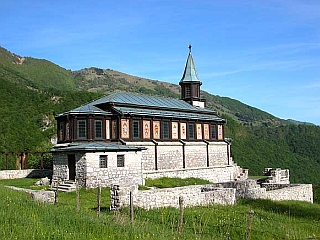
Perched on a hill above the Tolminka River in northwestern Slovenia, close to today’s border with Italy, is an attractive, intricately decorated church. With snow-capped Alps and expansive forests in the background, the Church of the Holy Ghost looks positively serene. However, it owes its mere existence to one of the bloodiest conflicts of all time.
During World War I, the infamous Isonzo Front ran through what is now northeastern Slovenia. Millions of soldiers fought in this beautiful mountainous landscape and hundreds of thousands were killed.
But in 1916, some soldiers and prisoners of war received a task that took them away from the slaughter of the front lines, at least for a while. Those select few spent most of the year building a church that would honor their fallen comrades.
The Church of the Holy Ghost, as the church was eventually dubbed, was designed by Vienna-based painter and set designer Remigius Geyling. His background is evident in the appearance of the building: the interior is covered with intricate white-blue-and-gold patterns, while the more restrained exterior is adorned with panels bearing paintings of Austria-Hungary’s various provinces. The base of the church is made of stone; the rest of the structure consists of larch wood – both elements typical of northwestern Slovenia.
Many of Austro-Hungarian soldiers working on the church were skilled craftsmen; many other were just lucky to get a temporary reprieve from the front lines. They immortalized their fallen Austro-Hungarian soldiers by burning their names onto oak panels in the church’s interior. Sometimes, a soldier who had burned names on the panes would later die on the front and have his name added by his comrades.
What ultimately makes the church so special, however, is its universal message of peace. In fact, many of the men who built it weren’t Austro-Hungarian at all, but their erstwhile enemies, Russian prisoners of war who were also brought in help out. And, unusually for the time, the church’s inscriptions address all of humanity: While the Austro-Hungarian coat-of-arms appears at the front of the church, it is joined by the universal Latin word “pax,” meaning peace.
Another inscribed Latin phrase is even more poignant: “Ultra cineres hostium ira non superset” – “May hatred not reach beyond the ashes of the dead.” In the midst of one of the most horrific cataclysms humanity has ever seen, the Church of the Holy Ghost came to symbolize the hope for a better, more peaceful tomorrow. Its message still resounds today, almost a century later.

































































